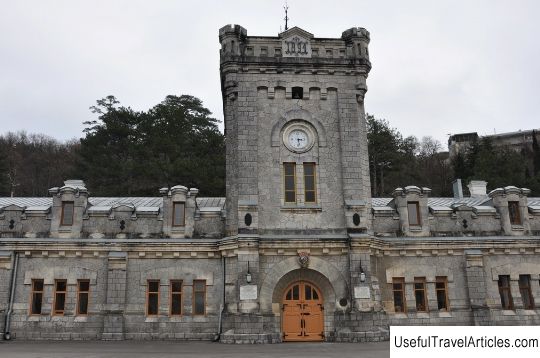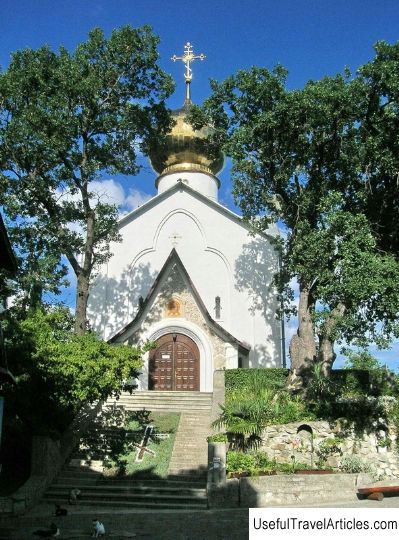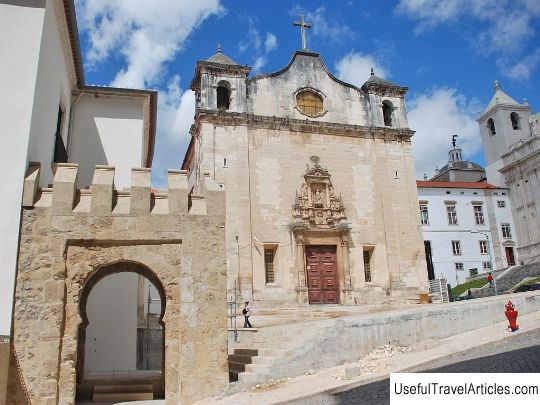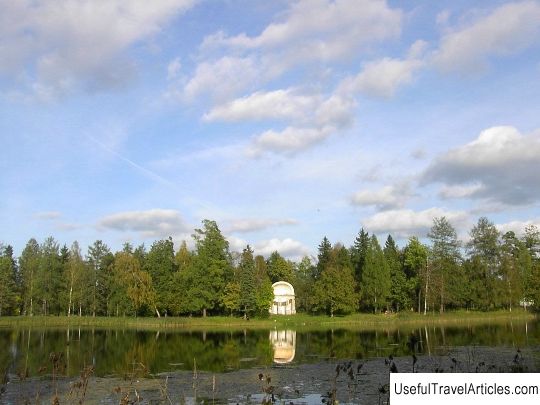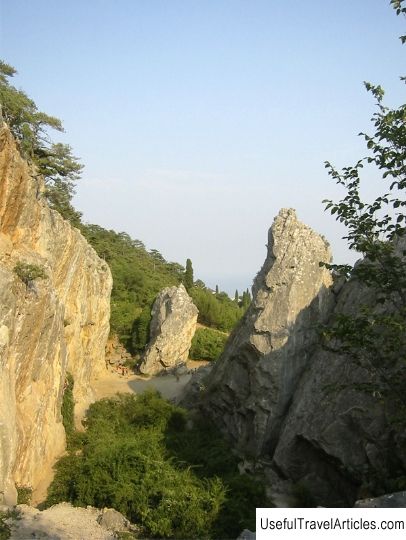Massandra Palace description and photo - Crimea: Yalta
Rating: 7,6/10 (293 votes) 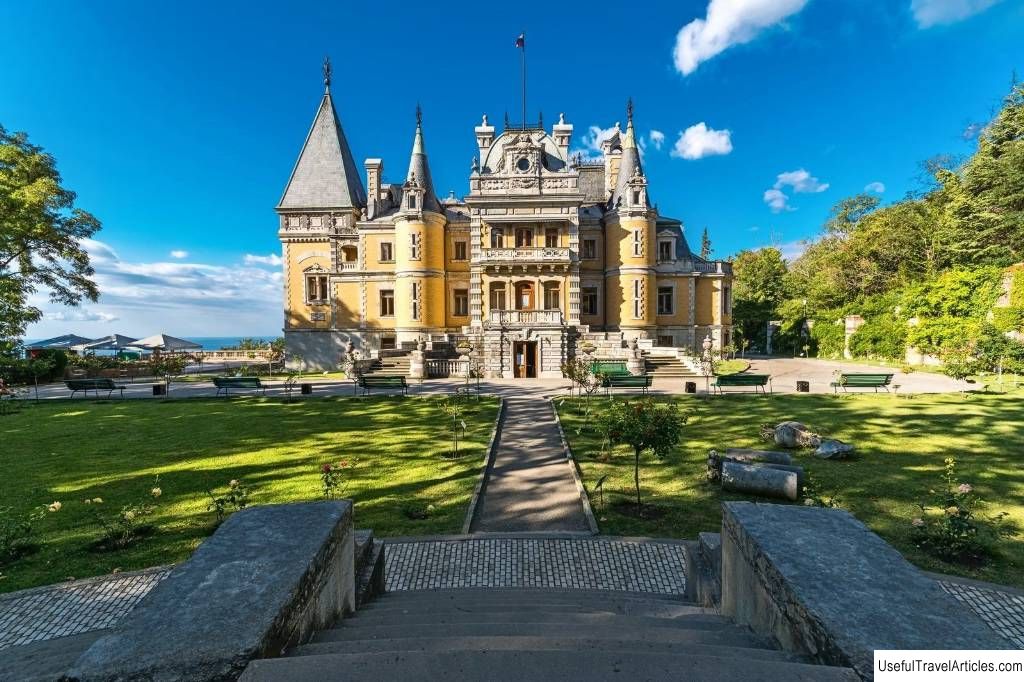
Massandra Palace description and photos - Crimea: Yalta. Detailed information about the attraction. Description, photos and a map showing the nearest significant objects. Photo and descriptionMassandra Palace - one of the best architectural monuments of the southern coast of Crimea - was built on the slopes of a mountain range, in a secluded place surrounded by forest. The village Massandra at the beginning of the 19th century belonged to the Potocki family . Sophia Pototskaya was the first to start landscaping these places. The famous beauty, a former Greek courtesan, was married for the second time to the richest magnate Stanislav Potocki. It was for her that he arranged the famous Sofiyivka park in Uman. In 1815, she acquired these places - perhaps to calmly rest here in her old age, and perhaps for children. She was already 55 years old by that time. After her death in 1822, the estate goes to her youngest daughter Olga Naryshkina . Olga is friends with the Vorontsovs, she is loved and taken care of by the wife of Mikhail Semenovich Vorontsov, the Novorossiysk governor and the then “owner” of Crimea - Elizaveta Ksaveryevna . Her mother buys Massandra for her daughter, and Vorontsov himself, of course, manages the estate. His main residence in the Crimea was the palace in Alupka, but he also came here. Under him, in an oak grove, the Assumption Church was built in the classical style, with antique porticoes and colonnades - this was in 1832. Unfortunately, it has not survived to this day - it was demolished after the revolution. Vorontsov continued to develop the local wine production, founded by the Pototskys. Vineyards were planted on the slopes of the mountains, wine cellars were arranged. Part of the estate in the middle of the century was sold to the treasury, and part remained with the Vorontsovs. Upper Massandra was owned by the son of Mikhail Semenovich - Semyon Mikhailovich . He spent all his life in the south in the wars for the Caucasus and the Crimea: he began in L.-G. Preobrazhensky regiment and fought against the mountaineers, passed the Crimean regiment and was wounded near Sevastopol. He finished his military career as the commander of the reserve corps, which was quartered in the Crimea. However, his life was not only about war. For example, he was keenly interested in ancient archeology and founded the Odessa Society of Fine Arts. He was married to the beauty and socialite Maria Vasilyevna Stolypin . She got married a second time, his parents were against this marriage. However, it took place, and was marked by misfortune - they had no children. It was she who was described by L. N. Tolstoy in his story "Hadji Murat". During this period - when he still commands the Crimean troops - Semyon Mikhailovich decides to build himself a new home. In 1881 he ordered an architect M.A. Bouchard palace in Massandra. Construction begins, but suddenly, in one year, both die - both the customer and the architect. The Vorontsovs' male line was interrupted, and his wife became the heiress. Building the palace In 1881, there was already a solid two-story building made of local limestone, with a galvanized roof and good metal ceilings, but completely without decoration and office space. The Vorontsovs were distinguished by the scale of their requests: the palace was guided by the French architecture of the 18th century, first of all, of course, to Versailles. However, it was rather modest in decor and was supposed to resemble a knight's castle in the mountains. In the eighties, the place was half-abandoned for a long time, Vorontsov's heirs had neither the means nor the desire to continue construction - even their palace in Alupka fell into decay in those years. In the end, in 1889, the estate was bought into the treasury for the emperor Alexander III . A new architect, Maximilian Mesmacher , got down to business. This was the rise of his career - at the same time he was ordered two grand palaces: the palace for Prince Alexei Alexandrovich in the capital (now it houses the St. Petersburg House of Music) and the palace for the emperor himself in Massandra. The architect has significantly changed the original appearance of the building due to the rich decor and details . One more floor was added, high chimneys rose above the roof, and the roof itself became pyramidal. The interior layout of the building was primarily focused on privacy and recreation, with some hint of classic "hunting lodges". There were almost no ceremonial rooms with high ceilings, the main rooms were residential, small and cozy. To cover the floors, wall cladding of utility rooms and park terraces, the so-called Metlach tiles were used - the best tiles of German production. It was produced by the company "Villeroi and Boch", which received the title of supplier to the Imperial Court. The interior decor also met the most fashionable trends of the late 19th - early 20th centuries: ceramics were widely used here, stoves and fireplaces were decorated majolica tiles by Emil Kremer and cast blackened copper . At first, decorative majolica was used mainly in merchant houses, but from the end of the century it became an element of palace interiors, and artists such as V. Vasnetsov or M. Vrubel . The decor of the doors was made with the help of burning and inlays with colored glass. The walls of many of the rooms were paneled with carved wood paneling, in a hunting style. Construction was carried out quite actively, the emperor came here from Livadia to watch him. But after his death in 1894 everything almost stopped again: the palace was finished only by 1902 . But even then not to the end: it was necessary to install electricity, connect the water supply, bring furniture and everything necessary for life ... As a result, it remained a "traveling palace": a place not intended for permanent life, but only for picnics and rest for several hours. They hunted here, people came here to pray. The Empress fell in love with the white "Vorontsov" Assumption Church . Nicholas II himself stayed here when he came to Massandra. He was keenly interested in the development of wine production. Just at the end of the 90s of the XIX century, the famous underground wine cellars were built here - now it is one of the main attractions of the city. Construction began under Alexander III, and by 1897 a central basement with seven diverging tunnels had already been built. Since 1898, the plant began producing wine using new technologies, with aging in these basements, where a stable temperature and humidity were maintained. Palace Park The park ensemble was founded here by Karl Kebakh , the main Crimean gardener of the 30-40s. XIX century. A hereditary gardener and botanist, he devoted many years to the creation of a park in Alupka. But he also worked in other Vorontsov estates - for example, in Massandra. In terms of area, the Massandra park is not inferior to the Alupka park - there are 42 hectares. It was created in the "English" style of a landscape park, with nooks and crannies, secret paths and natural arrangement of plants. Once upon a time there was a forest of hornbeams and oaks - the last oaks were cut down in Soviet times. Karl Kebach planted primarily conifers , which improve the air: Himalayan and Atlas cedars, junipers, various types of pines - both local and exotic. lemon and orange groves were planted. This is what allowed in the future to arrange a sanatorium here for tuberculosis patients - the air turned out to be truly healing. In Soviet times After the revolution, the palace was not plundered . All because there was nothing to rob here - it actually remained uninhabited until 1921, and in 1921 it was finally used: until the war, the palace and the park were used as a sanatorium. After the war, moved here the leadership of the Institute of Viticulture and Winemaking . The institute dates back to the school of viticulture, founded in 1828 in Magarach: not only wine was made here, but also various grape varieties were studied and the most promising ones were sent throughout the country. During the Soviet years, the institute continued to engage in grape breeding and scientific research. Now, in addition to a collection of wines of its own production, he has, for example, a unique collection of yeast cultures. But the place was too good: the institute soon left here, and the Massandra Palace became a famous "Stalinist" dacha ... True, it was used for official receptions and negotiations, and not for recreation. Stalin himself preferred a simple wooden house in Malaya Sosnovka - also not far from Massandra. The former royal palace seemed to him too large and uncomfortable. The whole complex was called the Government cottage number 3. Palace-Museum A museum was opened here in 1992 . Now it is considered a branch of the Alupka Museum-Reserve. A two-story exposition is open here, telling about the life of Alexander III and his family . The hall, reception rooms of the emperor and empress, their offices, the imperial bedroom ... The basis of the interiors has been preserved. The exhibits themselves are mostly transferred from other Crimean collections. The museum staff continues the gardening traditions of Karl Kebach: for several years in a row in June, a rose festival has been held here . There is also a "garden of aromas" with fragrant and medicinal plants. But this only applies to the immediate vicinity of the palace, where the regular part of the park with flower beds was once located. The main landscape part is separated from the museum territory by a highway and buildings, it is also now guarded and improved. Plates with the name are made under many exotic trees. Note
     We also recommend reading The Australian War Memorial description and photos - Australia: Canberra Topic: Massandra Palace description and photo - Crimea: Yalta. |

